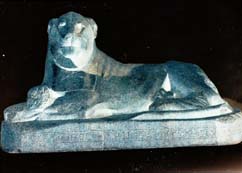Exhibition Reviews
| Home | | Museum Guide | | International | | Theater |
From Britain to Brooklyn - 3,000 Years of Egyptian Art

|
|
| Colossal red quartz lion, one of a pair from a Nubian temple of King Amenhotep III. Courtesy The British Museum/The Brooklyn Museum of Art. | |
"Eternal Egypt: Masterworks of Ancient Art from the British Museum"
The Brooklyn Museum of Art, 200 Eastern Parkway, Brooklyn. 718-638-5000.
Tickets: $10, students (13 - college) and seniors $8, children (6 - 12) $4.
Audio tours are included in the ticket price.
November 23, 2001--February 24, 2002
Reviewed by Paulanne Simmons
Chronicling the 3,000 years of Egyptian art is no mean task - even when you have the backing of the prestigious British museum. But the Brooklyn Museum of Art, world famous for its own Egyptian collection, has not flinched at the enormity of the task.
"Eternal Egypt: Masterworks of Ancient Art from the British Museum," opening November 23, is a pithy and penetrating look at not only the art but also the life and afterlife of Egyptians during 30 dynasties and the Ptolemaic period.
Great pharaohs such as Tutankhamun and Ramesses the Great are featured alongside priests, scribes, builders, state officials, and everyday citizens - a nursing woman, a man with a shaved head.
Of the more than 140 masterpieces guest curator Dr. Edna R. Russman has selected from the British Museum collection, there are many pieces that have never before traveled outside Britain. There's a good share of the monumental works that traditionally get the most attention - a 5,000-pound red granite lion and a colossal quartz head of Amenhotep III from his funerary temple in Thebes.
But viewers will not find the usual emphasis on mummies and sarcophagi, which has often lead people to believe the ancient Egyptians spent more time preparing for their deaths than enjoying their lives. This choice results in some pleasant surprises.
From the 6th Dynasty (ca. 2345 - 2181 B.C.) there's the naked striding figure of Meryrahashtef, made of ebony and sycamore and so lifelike the young man seems almost ready to topple over in his haste.
A Papyrus with Satirical Vignettes from the 20th Dynasty (ca. 1295 - 1069 B.C.) shows that the ancient Egyptians did indeed have a sense of humor.
But even when the exhibit does turn to Egyptian belief in the afterlife, Russman has chosen lesser-known objects. For example, beautifully and intricately illustrated sheets from several Book of the Dead papyrus rolls demonstrate the sophistication of Egyptian drawing.
What's more, exhibits are displayed with great respect - placed on walls or in glass cases far enough apart so viewers can spend considerable time with each object and not disrupt the flow of museum traffic. Subtle and effective lighting emphasizes angles and curves, and creates shadows that highlight shape.
The exhibit is accompanied by a film created by multi-media production company Owen Electric Pictures, produced and directed by Robin F. White, and narrated by British actress Kristen Scott-Thomas of The English Patient fame.
With commentary by W. Vivian Davies, Keeper of the Egyptian Collection for the British Museum, the film focuses on the culture of the ancient Egyptian people and three works of art in the exhibit: the stone head of Amenhotep III, the wooden figure of Meryrahashtef and a page from the Book of the Dead.
There's a decidedly didactic side to this exhibit. Explanations abound. Certainly they add to the quality of the exhibit. But any attempt at reading more than a fraction of the information offered will lead to frustration.
A far better approach for those who would like to immerse themselves in this visual experience is to save the explanations for later, after fully absorbing the magnitude and magnificence of "Eternal Egypt."[PS]